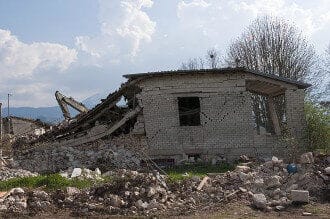By Harry Cooper – In a world becoming increasingly aware of climate change, the demand for renewable energy has never been higher. We have found many different forms of renewable energy from wind to solar to hydro. One of the less talked about, but still very viable sources of renewable electricity is geothermal energy.
Renewable Energy Beneath our Feet
Geothermal energy is energy that comes from the Earth itself, and uses the natural geothermal heat stored beneath the Earth’s surface to generate electricity. Geothermal can be used on a large scale at geothermal energy plants, or on a small scale with single building geothermal heating and cooling systems.
Like all forms of energy, geothermal energy has its benefits and drawbacks, but with new technologies in renewables coming out all the time, it is important to understand all the facts about the alternative energy sources that could save us from climate change.
How Does Geothermal Energy Work?
The Earth is filled with various layers, the inner core, the outer core, the mantle, and the crust. Each of these layers is incredibly hot except the crust, the thin top layer on which we live. However the inner layers are hot enough to heat certain parts of the Earth’s crust, specifically underground stores of hot springs. These hot springs are underground reservoirs of hot water that can be tapped into and used for geothermal energy.
In order to do this, geothermal plants drill down to the hot water and use the steam that comes off of it to spin turbines that produce electricity. This water can be reused by pumping it back into the Earth’s crust to be reheated by the planet’s natural internal energy which makes geothermal energy completely renewable, as it will never run out.
Types of Geothermal Power Plants
While the same principle of using the Earth’s internal heat for electricity generation applies to all geothermal systems, there are still some different types of geothermal energy production. In fact there are three main ways of conducting geothermal power generation at large scale geothermal power plants.
Dry Steam
Rather than relying on underground sources of water to create steam, dry steam power plants use already existing underground steam. The steam is directly pumped up to the turbine through geothermal heat pumps to create electricity in a fairly simple process. However, these underground reservoirs of steam are harder to find, and so dry stream plants are not very common, as there are only a handful of them around the world.
Flash Steam
Flash steam plants are the most common out of the three. Geothermal electricity generation form flash steam relies on underground pools of water that are over 360°F. These pools are under so much pressure that they tend to flow upwards of their own fruition, with little help from geothermal heat pump systems. Once they flow high enough, the water loses enough pressure to start boiling. Once the water is boiling it releases steam that then powers a generator.
Binary Steam
Binary steam is a process that makes use of cooler underground water that is not at boiling point, usually between 220°F and 360°F. The cooler water is then used to heat a second liquid with a lower boiling point that will create steam to power the turbines.
The Pros and Cons of Geothermal Energy
Like all emerging energy sources, geothermal energy has both pros and cons. While there are many benefits to powering our society with geothermal energy, there are also a few drawbacks that we need to take into consideration.
Pros
One of the most obvious advantages of using geothermal energy is that, as a renewable source of energy, it produces minimal greenhouse gases compared fossil fuels. Also unlike fossil fuels, geothermal energy is a perpetual resource, meaning that no matter how much we use of it, it will never run out.
Geothermal also has a few significant advantages over other renewable energy sources such as solar and wind energy. For instance, geothermal energy is much more consistent in its energy production. While solar and wind energies have to rely on the sun to be shining or the wind to be blowing, geothermal energy can operate at any time. Geothermal also needs very little land to function. While other renewables need massive wind and solar farms that can take up large swaths of land, geothermal only needs enough room to drill into the ground in order to produce energy.
Cons
While geothermal is incredibly efficient and renewable, it is not without its drawbacks. Since geothermal energy relies on pockets of hot water and steam beneath the Earth’s surface, it can only be built at specific spots, and these spots may not always be an ideal location for a power plant. Along with this, the deep drilling required to reach pockets of geothermal energy can cause instability in the Earth’s crust. This instability can lead to an increase in earthquake activity.
Another drawback to geothermal energy systems is that it has very high upfront costs, especially compared to other forms of renewable energy. While all renewables struggle with high upfront costs because of the amount of new infrastructure that needs to be built, geothermal energy is particularly expensive to build. On average, geothermal upfront costs are around 4,000 dollars to 6,000 dollars per kilowatt-hour produced. On the the other hand, solar energy costs around 1,250 dollars per kilowatt hour, and wind costs around 1,550 dollars per kilowatt hour. However, since geothermal is an efficient renewable energy source, it can pay itself off fairly easily.
At Home Geothermal
So far we’ve talked about using geothermal energy pockets from deep beneath the Earth’s surface to generate electricity through massive turbines. But geothermal energy can be utilized on a smaller scale too. In fact, it is even possible to heat and cool your home using a small geothermal system. These household geothermal systems are built around the fact that even ten feet below ground the Earth consistently remains around 50°F no matter what the season is or what the temperature is outside.
Geothermal Heating and Cooling Systems
At home geothermal systems work by using underground temperatures to heat and cool buildings directly. These systems involve installing underground coiled pipes filled with air or water that are regulated to the constant underground temperature of about 50°F. The air in these pipes is circulated, pumped into the building and then the air in the building is pumped back underground to be heated or cooled back to 50°F. The great thing about these kinds of systems is that since the underground temperature is kept constant they can easily work as both heating and cooling systems depending on the temperature outside.
The Advantages of Using Geothermal at Home
At home geothermal energy is incredibly beneficial and incredibly energy efficient. It is estimated that at home geothermal can help save up 70% off utility bills. This is because geothermal heating and cooling systems are thought to be around twice as efficient at cooling and around fifty percent more efficient at heating than traditional heating and cooling systems.
While these systems may seem like the perfect way to heat and cool any building, they don’t exactly come cheap. Home Geothermal systems can cost as much as 20,000 dollars. While this is a lot of money, geothermal systems also save lots of money on heating and cooling costs, and can usually pay themselves off in about seven to eight years, and can last for another 40 to 45 years before needing to be replaced. Some governments have started offering tax breaks to people installing at home geothermal systems.
Religion and Geothermal Energy
Geothermal energy is a wonderful renewable resource, but which must be channeled with wisdom. Cultures around the world have been benefiting from geothermal energy for thousands of years. Emily Pontecorvo wrote for Grist Magazine about some of the opportunities and dangers of geothermal energy. Pontecorvo describes how we could transition from geothermal power plants producing 0.5 percent of U.S. electricity, as they do currently, to producing up to 8.5 percent by 2050, according to an analysis by the Department of Energy. Geothermal power plants can play a crucial role in our transition to sustainable energy. But Pontecorvo also reminds us that that “the transition to renewables should not repeat historically exploitative practices.”
In extracting resources from the earth like oil, diamonds and many other resources, native people have been harmed through pollution, theft and enslavement. Native Americans in Nevada are worried that historical cycles of exploitation are repeating themselves as Ormat Technologies is poised to open a geothermal power plant next to one of the Fallon Paiute-Shoshone’s most sacred springs.
The Fallon Paiute-Shoshone Tribe and Center for Biological Diversity are suing the Bureau of Land Management (BLM) for approving the project. The lawsuit describes how members of the Fallon Paiute-Shoshone Tribe use the site for “healing, soaking, camping, and harvesting native plants for weaving and other uses. These practices require quiet for contemplation, and darkness to see the night sky.” The geothermal power plant would make continued use of the spring impossible. As Pontecorvo points out, “The geothermal company behind the Dixie Meadows project, Ormat Technologies, opened a geothermal power plant in 2011 about 40 miles away on another hot springs called Jersey Valley. The springs dried up entirely a few years after the plant began operating.”
We can utilize geothermal energy without harming people. Pontecorvo clarifies that geothermal power plants are often built in areas “with known geothermal resources close to the surface of the earth, which are often indicated by natural hot springs.” But she also cites research at the Department of Energy which points towards new ways “to tap into geothermal resources much deeper underground [which] could open up new areas to geothermal development, potentially sparing treasured natural resources like Dixie Meadows.” Since hot springs are often sacred for indigenous peoples and wonderful natural resources for everyone, it is good to know that research is being conducted to find ways to utilize geothermal energy without harming them. God willing, we will transition towards sustainable energy as peacefully as possible, with all of humanity fighting on the same side.
* Featured image source






